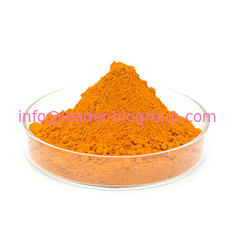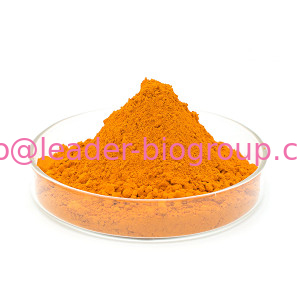| Description |
Riboflavin-5-phosphate sodium (sodium FMN) consist mainly monosodium salt of Riboflavin 5-phophate (FMN), the 5-monophosphate ester of riboflavin. Riboflavin-5-phosphate sodium is produced by direct reaction of riboflavin with a phosphorylating agent such as phosphorous oxychloride in an organic solvent.
Riboflavin 5-phophate (FMN) is essential as a coenzyme in various enzymic reactions in the body and is therefore used in the form of its salts, especially in the form of sodium FMN, as additive to drugs and human and animal food. Sodium FMN is also used as starting material for flavin adenine dinucleotide which is employed for treating vitamin B2 deficiency. It is used as a yellow food color additive (E106). Riboflavin 5-phosphate sodium is fairly stable in air but is hygroscopic and sensitive to heat and light. The product may be stored for 33 months from the date of manufacture in the unopened original container and at a temperature below 15 °C. |
| References |
[1] https://en.wikipedia.org/wiki/Flavin_mononucleotide
[2] Scientific Opinion on the re-evaluation of riboflavin (E101(i)) and riboflavin-5’-phosphate sodium (E 101(ii)) as food additives, EFSA Journal 2013
[3] Patent US 5095115A: Preparation of riboflavin 5'-phosphate (fmn) and its sodium salt in a lactone |
| Chemical Properties |
Riboflavin 5'-Monophosphate Sodium Salt is a yellow toorange-yellow, crystalline hygroscopic powder. It is odorless, and has a slightly bitter taste.

It is soluble in water, and practically insoluble in ethanol(95), in chloroform and in diethyl r.
It is decomposed on exposure to light. |
| Uses |
One of the bioactive forms of Riboflavin. Nutritional factor found in milk, eggs, malted barley, liver, kidney, heart, leafy vegetables. Richest natural source is yeast. Minute amounts present in all plant and animal cells. Vitamin (enzyme cofactor). |
| Uses |
antibacterial.
Riboflavin 5′-monophosphate sodium salt was used as water-soluble model drug in a combined conventional inkjet printing technology with flexographic printing for the fabrication of drug delivery systems.It may be employed as initiator for the photo-initiated polymerization of acrylamide.It may be employed in chronoamperometric assay for vanadium ions.
Riboflavin 5′-monophosphate is also known as flavin mononucleotide (FMN). FMN is a water-soluble micronutrient. It is enzymatically produced from riboflavin (RF).Riboflavin 5′-monophosphate is one of the constituent of enzyme cofactor flavin-adenine dinucleotide. |
| Biological Functions |
Riboflavin 5'-Phosphate Sodium is the phosphate sodium salt form of riboflavin, a water-soluble and essential micronutrient that is the principal growth-promoting factor in naturally occurring vitamin B complexes. Riboflavin phosphate sodium is converted to 2 coenzymes, flavin mononucleotide (FMN) and flavin adenine dinucleotide (FAD), which are necessary for energy production by aiding in the metabolism of fats, carbohydrates and proteins and are required for red blood cell formation and respiration, antibody production and for regulating human growth and reproduction. Riboflavin phosphate sodium is essential for healthy skin, nails and hair growth. |
| Purification Methods |
Purify FMN by paper chromatography using tert-butanol/water, cutting out the main spot and eluting it with water. It can also be purified by adsorption onto an apo-flavodoxin column, followed by elution and freeze drying. It crystallises from aqueous acidic solution. [Mayhew & Strating Eur J Biochem 59 539 1976, Beilstein 26 III/IV 2555.] |

